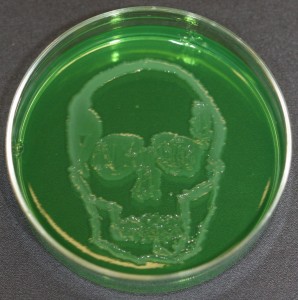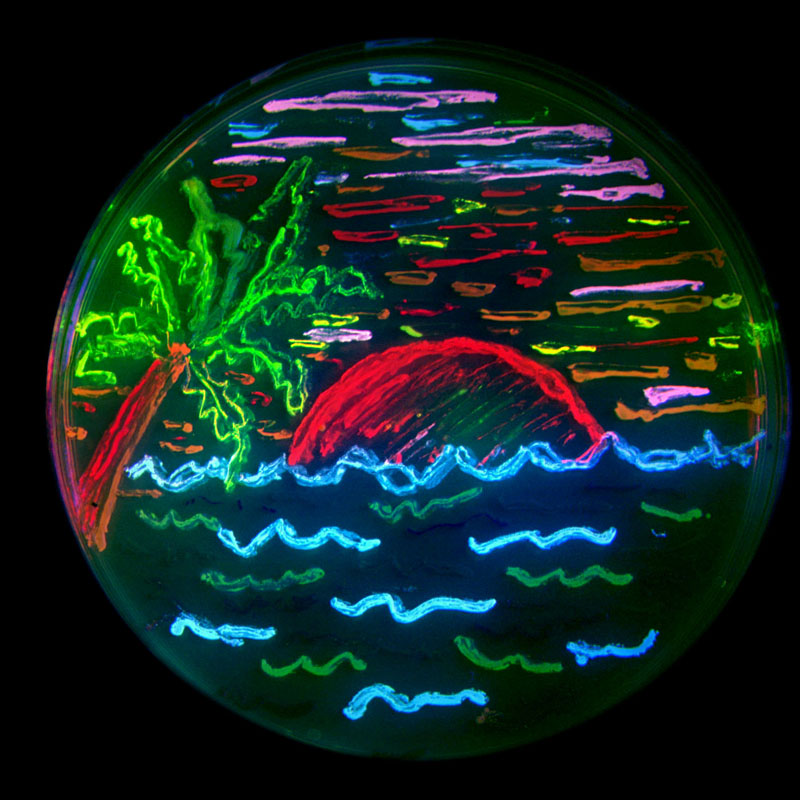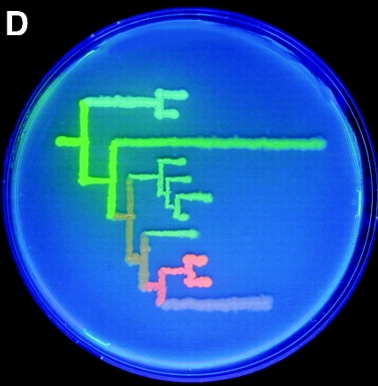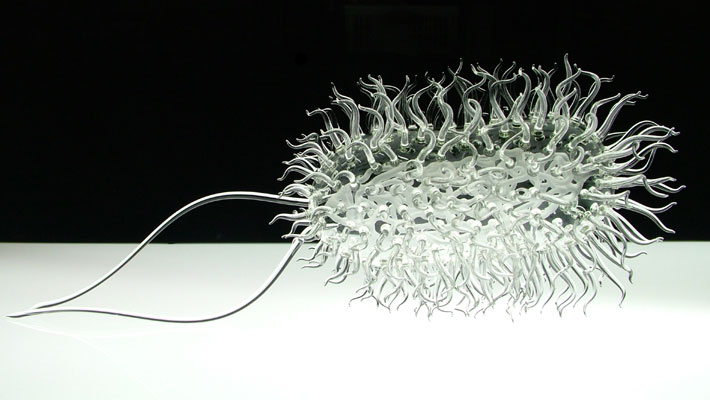UPDATE — Visit www.microbialart.com!
Some more creations by students in my lab:

Archaeopteryx

Galapagos Islands

Skull

Primate phylogeny

UPDATE — Visit www.microbialart.com!
Some more creations by students in my lab:

Archaeopteryx

Galapagos Islands

Skull

Primate phylogeny
David Sloan Wilson, author of various books — most recently Evolution for Everyone — and a proponent of group selection, has started up a blog at ScienceBlogs entitled Evolution for Everyone.
No paper out yet, and not even any details made available, but this looks interesting:
Reduced genome works fine with 2000 chunks missing
To put a figure on how much of our DNA is non-essential, Vrijenhoek and his colleagues screened the genomes of 600 healthy students, searching for chunks of DNA at least 10,000 base pairs in length that were missing in some individuals. Across all the genomes, about 2000 such chunks were missing – amounting to about 0.12 per cent of the total genome.
Some people will over-interpret this as strong evidence for a majority of “junk DNA”. Comprising only 0.12% of the genome, it isn’t. However, as these are natural deletions >10kb, it gets around the objections to the deletion studies (i.e., that the conditions in the lab weren’t the same as the challenges faced in the wild). Then again, it may be that you can have one or two deletions and be ok because there is some redundancy, but if you were missing all of these bits you’d be in trouble. Others will dismiss it as an artifact or somehow not really testing the claim (read: dogmatic assumption) that all DNA is functional, but what else is new.
Yep, according to a study coming out in PNAS and supported by NESCent.
(As usual, the news comes out before the PNAS article is actually available, so I can’t comment on the study).
Are Humans Still Evolving? Absolutely, Says A New Analysis Of A Long-term Survey Of Human Health
Byars, S., D. Ewbank, et al. (2009). Natural selection in a contemporary human population. Proceedings of the National Academy of Sciences 106, in press.
As I mentioned in my previous post, my students and I have been experimenting with creating art from living colonies of bacteria:




And here are some using fungi and bacteria by Dr. Niall Hamilton:






From Oct. 9-30, the University of Guelph and Ed Video are hosting a special art exhibit entitled “This View of Life: Evolutionary Art for the Year of Darwin“. It was organized by professors in four departments: Integrative Biology, Philosophy, History, and English and Theatre Studies, and was curated by Scott McGovern of Ed Video. The exhibit features art by 10 artists, all inspired by the themes of evolution, Darwin, and biodiversity. The Gregory Lab contributed some installations as well, which are shown in this brief clip from just before the opening reception on Oct. 16 (about 200 people attended the event). The first window shows live Daphnia magna (“water fleas”) to depict the concept of overproduction; they also are of interest because they reproduce asexually (the evolution of sexual reproduction being an important question in evolutionary theory). The second window presents images created using live colonies of E. coli bacteria. These last only a few days, so many different images will be displayed throughout the exhibit. The third window shows a projection of a remarkable collection of images of bacterial colonies kindly provided by Dr. Eshel Ben-Jacob.
Here are some more photos of the artwork:
Special thanks to everyone involved in organizing the exhibit, to the artists, and to the following graduate students who are talented artists in their own right: Joao Lima, John Wilson, Tyler Elliott, Paola Pierossi, Nick Jeffery.
You may notice a slightly different URL for the blog. I have moved to WordPress and away from Blogger. Other than the new look, you shouldn’t notice much difference — the feed is the same, all the posts are here, and the old posts redirect to the new blog. However, please update your bookmarks and blogrolls to http://www.genomicron.evolverzone.com/.
I liked it.
Overall, I think the Discovery Channel did a good job of capturing the painstaking work that goes into scientific research, in this case spanning more than 15 years from discovery to publication. Some other quick thoughts:
Some instructors have lamented the challenges of teaching students who are constantly logged-on, plugged-in, facebooked, etc.
Guess what? I like teaching the iGeneration*. I enjoy using YouTube clips in my lectures, putting together online discussions, and making use of blogs and online resources. I like the fact that they all have laptops (but not if they’re rude enough to play games during class). I appreciate that I can upload my lecture notes as PDF files and they will all be able to bring them to lectures. I have a BlackBerry, an iPod, a netbook, a blog (obviously), a document scanner, and miscellaneous other gadgets. I hate being offline as much as my students do.
I think it really depends on whether you feel that technology is a friend or a foe. If you consider it all just a huge distraction and a competitor for their attention, you’re likely to dislike current technological trends. If, on the other hand, you embrace it, try to keep up with it (or better yet, stay ahead of your students), and use it to connect with the class, then it can be really very exciting.
_____________
* The only thing I don’t like is the excessive use of the word “like” that is common among students… though it did inspire me to create a t-shirt:
The folks over at Science and Religion Today were interested in our study on graduate student conceptions of evolution, and asked me to give some thoughts on the question “How detailed an understanding of evolution do we need?” Here is my answer.
If by “we†you mean “scientists,†then it is extremely important that we gain as detailed an understanding of evolutionary mechanisms and the patterns of diversification that they have produced as we can. The question of the origins of biological diversity is a fundamental one, and obtaining as complete an answer as possible is a primary goal of the life sciences. Evolution is to biology what the periodic table is to chemistry: It makes sense of otherwise disconnected pieces of information and provides the framework for further investigation.
If you mean “students enrolled in science programs,†either undergraduates or grad students (as in our study), then I would say that a good working knowledge of evolutionary theory, though not a full understanding of all its nuances, should be a major goal. Again, evolution is the unifying principle of biology, and without grasping how it works, one cannot make sense of the history and current diversity of life on this planet. Most science majors will not go on to become professional evolutionary researchers, but many will become teachers, researchers in industry or government, consultants, doctors, politicians, or any of a wide range of careers in which a working knowledge of evolution is important. As I tell the students in my course when I discuss why they should work hard to understand evolution, if the goal is to have a scientifically literate public, who but the future teachers and other educated citizens can make that happen?
If you mean “members of the public at large,†then I would say that at least a basic understanding of evolution is still important, if not for academic reasons then for pragmatic ones. Evolutionary knowledge informs decisions in medicine, agriculture, resource management, and many other areas. If, as I am sure most biologists feel, an understanding of evolution is important at all levels, then it is important that it be taught—and taught properly—from elementary school to graduate school. A population that recognizes the standing and relevance of evolutionary principles is one that will support this endeavor, whereas one that misunderstands or fears evolutionary biology will seek to undermine science education. There is an inevitable feedback loop in this regard, and effective education is the way to make it a positive one.
How detailed an understanding of evolution do we need? It depends on who “we†are—but “very little†is not the answer in any case.